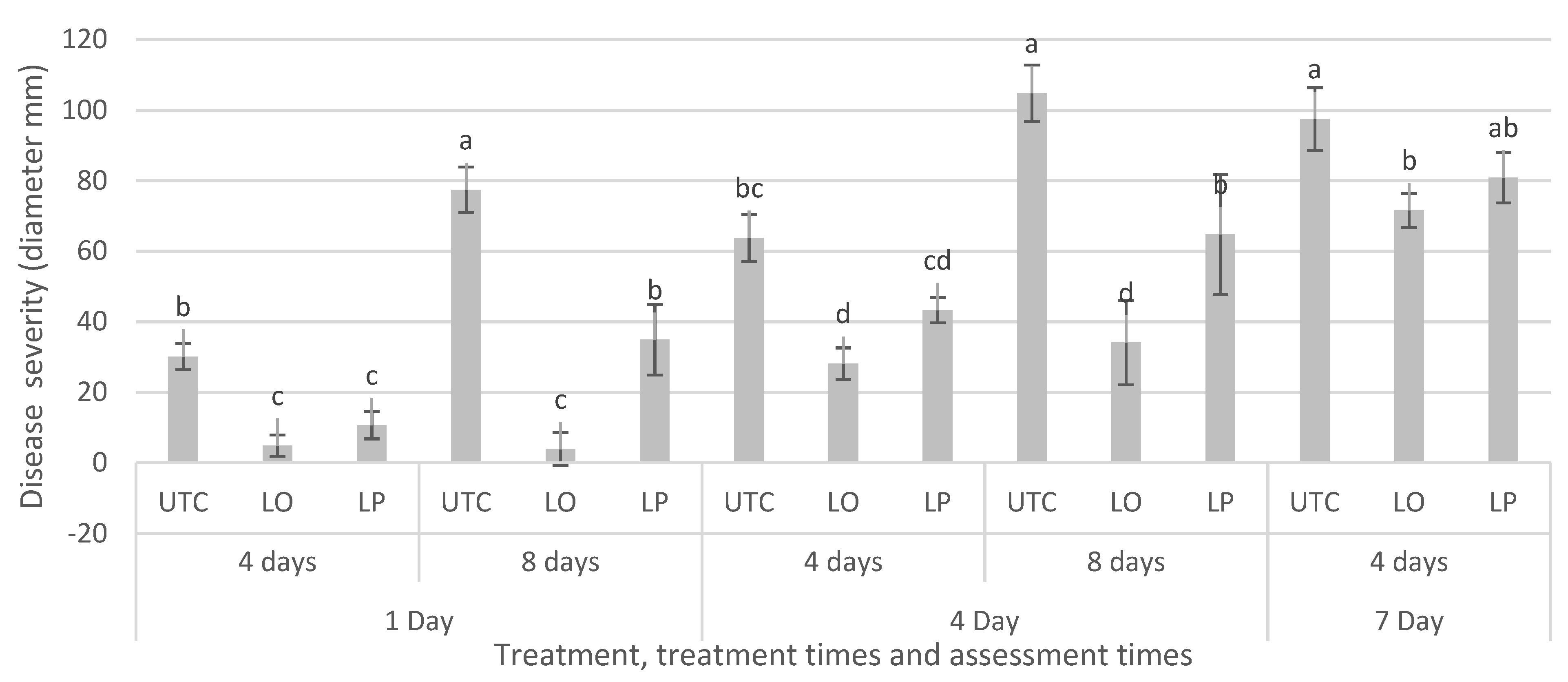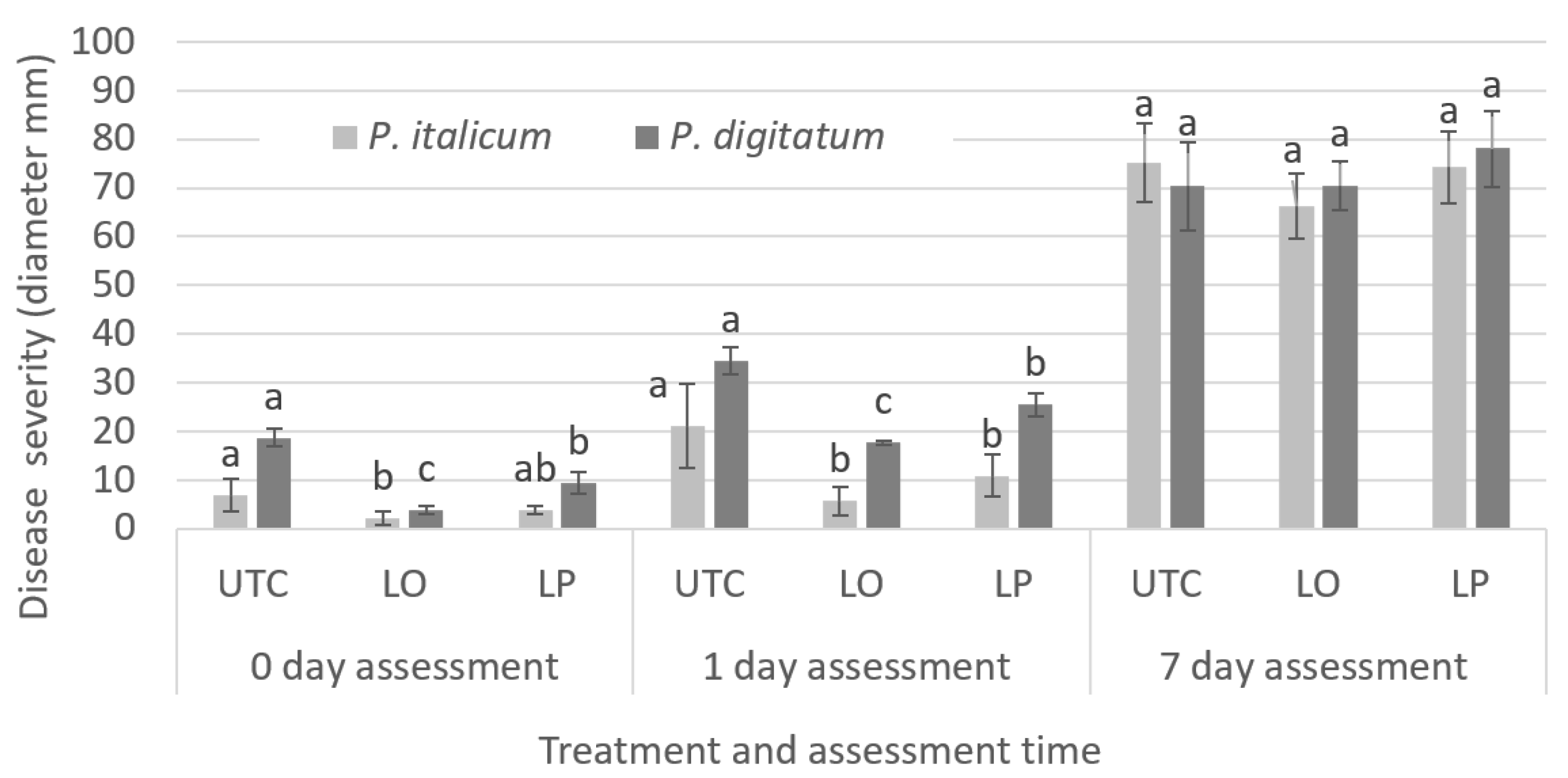Effect of Low Pressure and Low Oxygen Treatments on Fruit Quality and the In Vivo Growth of Penicillium digitatum and Penicillium italicum in Oranges
Abstract
:1. Introduction
2. Materials and Methods
2.1. Fruits and Inoculation
2.2. LO Storage Treatments
2.3. LP Storage Treatments
2.4. Untreated Control
2.5. Fruit Quality
2.6. Ethylene Treatment
2.7. Weight Loss
2.8. Fruit Firmness
2.9. Statistical Analysis
3. Results and Discussion
4. Conclusions
Supplementary Materials
Author Contributions
Funding
Institutional Review Board Statement
Data Availability Statement
Acknowledgments
Conflicts of Interest
References
- Golding, J.; Archer, J. Advances in postharvest handling of citrus fruit. In Achieving Sustainable Cultivation of Tropical Fruits; Burleigh Dodds Science Publishing Limited: Cambridge, UK, 2019; pp. 65–90. [Google Scholar]
- Palou, L. Chapter 2—Penicillium digitatum, Penicillium italicum (Green Mold, Blue Mold). In Postharvest Decay; Bautista-Baños, S., Ed.; Academic Press: San Diego, CA, USA, 2014; pp. 45–102. [Google Scholar]
- Vilanova, L.; López-Pérez, M.; Ballester, A.-R.; Teixidó, N.; Usall, J.; Lara, I.; Viñas, I.; Torres, R.; González-Candelas, L. Differential contribution of the two major polygalacturonases from Penicillium digitatum to virulence towards citrus fruit. Int. J. Food Microbiol. 2018, 282, 16–23. [Google Scholar] [CrossRef] [Green Version]
- Romanazzi, G.; Sanzani, S.M.; Bi, Y.; Tian, S.; Gutiérrez Martínez, P.; Alkan, N. Induced resistance to control postharvest decay of fruit and vegetables. Postharvest Biol. Technol. 2016, 122, 82–94. [Google Scholar] [CrossRef]
- Burg, S.P. Postharvest Physiology and Hypobaric Storage of Fresh Produce; CABI Publisher: Cambridge, MA, USA, 2004. [Google Scholar]
- Luengwilai, K.; Sukjamsai, K.; Kader, A.A. Responses of ‘Clemenules Clementine’ and ‘W. Murcott’ mandarins to low oxygen atmospheres. Postharvest Biol. Technol. 2007, 44, 48–54. [Google Scholar] [CrossRef]
- An, D.S.; Park, E.; Lee, D.S. Effect of hypobaric packaging on respiration and quality of strawberry and curled lettuce. Postharvest Biol. Technol. 2009, 52, 78–83. [Google Scholar] [CrossRef]
- Jiao, S.; Johnson, J.A.; Tang, J.; Mattinson, D.S.; Fellman, J.K.; Davenport, T.L.; Wang, S. Tolerance of codling moth, and apple quality associated with low pressure/low temperature treatments. Postharvest Biol. Technol. 2013, 85, 136–140. [Google Scholar] [CrossRef]
- Romanazzi, G.; Nigro, F.; Ippolito, A. Effectiveness of a short hyperbaric treatment to control postharvest decay of sweet cherries and table grapes. Postharvest Biol. Technol. 2008, 49, 440–442. [Google Scholar] [CrossRef]
- Ladaniya, M.S. Storage systems and response of citrus fruits. In Citrus Fruit. Biology, Technology and Evaluation; Ladaniya, M.S., Ed.; Academic Press: San Diego, CA, USA, 2008; pp. 333–373. [Google Scholar]
- Spalding, D.H.; Reeder, W.F. Low pressure (hypobaric) storage of limes. J. Am. Soc. Hort. Sci. 1976, 101, 367–370. [Google Scholar]
- Hashmi, M.S.; East, A.R.; Palmer, J.S.; Heyes, J.A. Hypobaric treatment stimulates defence-related enzymes in strawberry. Postharvest Biol. Technol. 2013, 85, 77–82. [Google Scholar] [CrossRef]
- Li, L.; Zhang, M.; Adhikari, B.; Gao, Z. Recent advances in pressure modification-based preservation technologies applied to fresh fruits and vegetables. Food Rev. Int. 2017, 33, 538–559. [Google Scholar] [CrossRef]
- Dilley, D.R. Hypobaric storage of perishable commodities fruits, vegetables, flowers and seedlings. Acta Hortic. 1977, 62, 61–70. [Google Scholar] [CrossRef]
- Romanazzi, G.; Nigro, F.; Ippolito, A. Short hypobaric treatments potentiate the effect of chitosan in reducing storage decay of sweet cherries. Postharvest Biol. Technol. 2003, 29, 73–80. [Google Scholar] [CrossRef]
- Pristijono, P.; Scarlett, C.J.; Bowyer, M.C.; Vuong, Q.V.; Stathopoulos, C.E.; Jessup, A.J.; Golding, J.B. Use of low-pressure storage to improve the quality of tomatoes. J. Hortic. Sci. Biotechnol. 2017, 92, 583–590. [Google Scholar] [CrossRef] [Green Version]
- Pristijono, P.; Bowyer, M.C.; Scarlett, C.J.; Vuong, Q.V.; Stathopoulos, C.E.; Golding, J.B. Effect of low-pressure storage on the quality of green capsicums (Capsicum annum L.). J. Hortic. Sci. Biotechnol. 2017, 93, 1–8. [Google Scholar] [CrossRef]
- Burg, S.P. (Ed.) Hypobaric Storage in Food Industry. In Hypobaric Storage in Food Industry; Academic Press: San Diego, CA, USA, 2014; pp. 115–142. [Google Scholar]
- Montesinos-Herrero, C.; del Río, M.A.; Rojas-Argudo, C.; Palou, L. Short exposure to high CO2 and O2 at curing temperature to control postharvest diseases of citrus fruit. Plant Dis. 2012, 96, 423–430. [Google Scholar] [CrossRef] [PubMed] [Green Version]
- Montesinos-Herrero, C.; Smilanick, J.L.; Tebbets, J.S.; Walse, S.; Palou, L. Control of citrus postharvest decay by ammonia gas fumigation and its influence on the efficacy of the fungicide imazalil. Postharvest Biol. Technol. 2011, 59, 85–93. [Google Scholar] [CrossRef]
- Jiao, S.; Johnson, J.A.; Fellman, J.K.; Mattinson, D.S.; Tang, J.; Davenport, T.L.; Wang, S. Evaluating the storage environment in hypobaric chambers used for disinfesting fresh fruits. Biosyst. Eng. 2012, 111, 271–279. [Google Scholar] [CrossRef]
- Pristijono, P.; Papoutsis, K.; Scarlett, C.J.; Bowyer, M.C.; Vuong, Q.V.; Stathopoulos, C.E.; Golding, J.B. Postharvest UV-C treatment combined with 1-methylcyclopropene (1-MCP), followed by storage in continuous low-level ethylene atmosphere, improves the quality of tomatoes. J. Hortic. Sci. Biotechnol. 2017, 92, 521–529. [Google Scholar] [CrossRef] [Green Version]
- Alhassan, N.; Bowyer, M.; Wills, R.; Golding, J.; Pristijono, P. Postharvest dipping with 3,5,6-trichloro-2-pyridiloxyacetic acid solutions delays calyx senescence and loss of other postharvest quality factors of ‘Afourer’ mandarins, Navel and Valencia oranges. Sci. Hortic. 2020, 272, 109572. [Google Scholar] [CrossRef]
- Thakur, R.; Pristijono, P.; Golding, J.B.; Stathopoulos, C.E.; Scarlett, C.J.; Bowyer, M.; Singh, S.P.; Vuong, Q.V. Development and application of rice starch based edible coating to improve the postharvest storage potential and quality of plum fruit (Prunus salicina). Sci. Hortic. 2018, 237, 59–66. [Google Scholar] [CrossRef] [Green Version]
- Van der Steen, C.; Jacxsens, L.; Devlieghere, F.; Debevere, J. Combining high oxygen atmospheres with low oxygen modified atmosphere packaging to improve the keeping quality of strawberries and raspberries. Postharvest Biol. Technol. 2002, 26, 49–58. [Google Scholar] [CrossRef]
- Archer, J.; Pristijono, P.; Vuong, Q.; Palou, L.; Golding, J. Preliminary investigations on the effect of low-pressure treatment on in vitro and in vivo growth of Penicillium sp. in oranges. Acta Hortic. 2019, 1325, 55–58. [Google Scholar] [CrossRef]
- Pristijono, P.; Bowyer, M.C.; Scarlett, C.J.; Vuong, Q.V.; Stathopoulos, C.E.; Golding, J.B. The application of low pressure storage to maintain the quality of zucchinis. N. Z. J. Crop Hortic. Sci. 2018, 46, 254–263. [Google Scholar] [CrossRef]
- Hagenmaier, R.D. The flavor of mandarin hybrids with different coatings. Postharvest Biol. Technol. 2002, 24, 79–87. [Google Scholar] [CrossRef]
- Moscoso-Ramírez, P.A.; Palou, L. Effect of ethylene degreening on the development of postharvest penicillium molds and fruit quality of early season citrus fruit. Postharvest Biol. Technol. 2014, 91, 1–8. [Google Scholar] [CrossRef]




| UTC 101.3 kPa + 100% RH | LP 6.6 kPa + 100% RH | LO 101.3 kPa + low O2 + 100% RH | ||||
|---|---|---|---|---|---|---|
| % | kPa | % | kPa | % | kPa | |
| 101.3 | 6.6 | 101.3 | ||||
| H2O | 2.30% | 2.3 | 35.00% | 2.3 | 2.3% | 2.3 |
| N2 | 76.3% | 77.3 | 50.8% | 3.4 | 96.7% | 98.0 |
| O2 | 20.5% | 20.7 | 13.6% | 0.9 | 0.9% | 0.9 |
| Ar | 0.9% | 0.9 | 0.6% | 0.04 | 0.04% | 0.04 |
| CO2 | 0.04% | 0.04 | 0.0004% | 0.00172 | 0.02% | 0.02 |
| Total | 100% | 98.932 | 100% | 4.3 | 100% | 98.99 |
| Ethylene Production (μL C2H4/kg/h) | Respiration Rate (mLCO2/kg/h) | Ethanol (μL/L) | TSS (°Brix) | TA (% Citric Acid) | MI | Weight Loss (g) | Firmness (J) | ||
|---|---|---|---|---|---|---|---|---|---|
| Treatment duration | |||||||||
| Upon removal from treatment | |||||||||
| Time Zero | 0 | 9.7 | 8.1 | 4.2 b | 9.7 | 1.0 | 9.3 | 0.0 d | |
| UTC | 4 | ND | 5.4 | 4.9 b | 9.8 | 1.1 | 9.2 | 47.6 b | 0.05 |
| 8 | ND | 6.2 | 6.6 b | 9.6 | 1.1 | 9.1 | 102.2 a | ||
| Low Oxygen | 4 | ND | 5.4 | 27.2 b | 9.5 | 1.0 | 9.6 | 14.9 c | 0.05 |
| 8 | ND | 6.2 | 53.9 a | 9.5 | 1.0 | 9.7 | 20.7 c | ||
| Low Pressure | 4 | ND | 5.4 | 61.8 a | 9.5 | 1.0 | 9.8 | 24.9 c | 0.06 |
| 8 | ND | 6.2 | 65.9 a | 9.5 | 1.1 | 8.9 | 24.2 c | ||
| LSD | NS | 24.0 | NS | NS | NS | 11.5 | NS | ||
| After 4 days air storage at 20 °C | |||||||||
| UTC | 4 | ND | 7.4 | 4.1 d | 9.6 | 1.0 | 9.4 | 99.9 a | |
| 8 | ND | 3.9 | 3.6 d | 9.6 | 1.1 | 8.9 | 111.8 a | 0.03 | |
| Low Oxygen | 4 | ND | 6.6 | 35.0 c | 9.8 | 0.9 | 10.4 | 34.4 b | |
| 8 | ND | 7.4 | 73.9 a | 9.7 | 1.1 | 9.0 | 38.8 b | 0.04 | |
| Low Pressure | 4 | ND | 5.4 | 21.9 c | 9.6 | 1.1 | 8.7 | 39.7 b | |
| 8 | ND | 6.2 | 55.7 b | 9.7 | 1.1 | 9.1 | 42.5 b | 0.04 | |
| LSD | NS | 13.9 | NS | NS | NS | 26.3 | NS | ||
| After 7 days air storage at 20 ℃ | |||||||||
| UTC | 4 | ND | 5.4 | 1.6 d | 9.8 | 1.0 | 9.4 | 104.8 b | |
| 8 | 12.5 | 6.2 | 3.4 d | 9.6 | 1.1 | 8.9 | 159.5 a | 0.03 | |
| Low Oxygen | 4 | ND | 4.9 | 28.0 c | 9.7 | 1.0 | 9.5 | 42.1 f | |
| 8 | 9.1 | 5.0 | 93.5 a | 9.6 | 1.0 | 9.3 | 59.8 cd | 0.04 | |
| Low Pressure | 4 | ND | 5.1 | 21.6 c | 9.7 | 1.1 | 9.2 | 56.1 cd | |
| 8 | 9.1 | 4.7 | 67.9 b | 9.6 | 1.0 | 9.6 | 72.7 c | 0.04 | |
| LSD | NS | 10.2 | NS | NS | NS | 25.6 | NS | ||
Publisher’s Note: MDPI stays neutral with regard to jurisdictional claims in published maps and institutional affiliations. |
© 2021 by the authors. Licensee MDPI, Basel, Switzerland. This article is an open access article distributed under the terms and conditions of the Creative Commons Attribution (CC BY) license (https://creativecommons.org/licenses/by/4.0/).
Share and Cite
Archer, J.; Pristijono, P.; Vuong, Q.V.; Palou, L.; Golding, J.B. Effect of Low Pressure and Low Oxygen Treatments on Fruit Quality and the In Vivo Growth of Penicillium digitatum and Penicillium italicum in Oranges. Horticulturae 2021, 7, 582. https://doi.org/10.3390/horticulturae7120582
Archer J, Pristijono P, Vuong QV, Palou L, Golding JB. Effect of Low Pressure and Low Oxygen Treatments on Fruit Quality and the In Vivo Growth of Penicillium digitatum and Penicillium italicum in Oranges. Horticulturae. 2021; 7(12):582. https://doi.org/10.3390/horticulturae7120582
Chicago/Turabian StyleArcher, John, Penta Pristijono, Quan V. Vuong, Lluís Palou, and John B. Golding. 2021. "Effect of Low Pressure and Low Oxygen Treatments on Fruit Quality and the In Vivo Growth of Penicillium digitatum and Penicillium italicum in Oranges" Horticulturae 7, no. 12: 582. https://doi.org/10.3390/horticulturae7120582
APA StyleArcher, J., Pristijono, P., Vuong, Q. V., Palou, L., & Golding, J. B. (2021). Effect of Low Pressure and Low Oxygen Treatments on Fruit Quality and the In Vivo Growth of Penicillium digitatum and Penicillium italicum in Oranges. Horticulturae, 7(12), 582. https://doi.org/10.3390/horticulturae7120582








